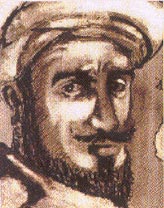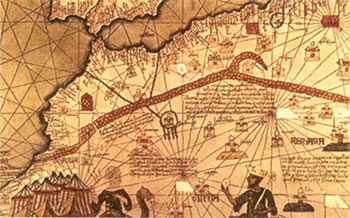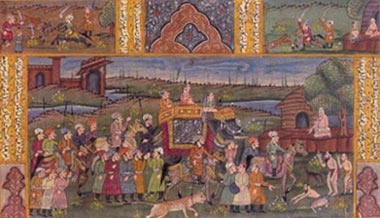|
The
most famous of all travelers of the
medieval world is Marco Polo. He was a
remarkable man who ventured into unknown
distant lands. He was a man who discovered
extraordinary places on his vast journeys,
and who told the magnificent tale of his
encounters with foreign peoples and
unfamiliar cultures. But how many of us
know that another man, living and
traveling in roughly the same period of
history, had journeyed more than Marco
Polo? This man was an Arab by the name of
Ibn Battuta, the most traveled person of
his time, traveling an estimated 75,000
miles. He was also the only medieval
traveler to have seen the lands of every
Muslim ruler of his time.
On what was planned to be his Hajj trip
to Mecca, Ibn Battuta journeyed
throughout North Africa and Syria. Then
he explored the Middle East, Persia,
Mesopotamia, and Asia Minor. He traveled
to the Indian Subcontinent, spending
there nearly a decade at the palace of
the Sultan of Delhi. The Sultan
appointed him as an ambassador to China.
 After about 30 years for exploring, around
the year 1350, Ibn Battuta started making
his way back to his homeland. He went back
to Fez, Morocco. There, at the court of
Sultan Abu 'Inan, he read out accounts of
his travels to Ibn Juzay who made them
into a book. This book exists today and is
known as Rihla or The Travels.
After about 30 years for exploring, around
the year 1350, Ibn Battuta started making
his way back to his homeland. He went back
to Fez, Morocco. There, at the court of
Sultan Abu 'Inan, he read out accounts of
his travels to Ibn Juzay who made them
into a book. This book exists today and is
known as Rihla or The Travels.
The Rihla told of the adventures
Ibn Battuta experienced on his travels.
Numerous times he was assaulted, once he
nearly drowned in a shipwreck; another
time he was close to being executed by a
tyrant leader. He married a number of
times and had more than one lover, which
consequently made him a father to several
children along his journeys.
The following paragraphs offer a closer
account and some alluring details about
the life of the greatest Arab and medieval
traveler.
From Tangier to 30 Years of Travels
Ibn Battuta was a North African Arab born
in Tangier, Morocco in 1304. His family
was a traditional Muslim family of judges.
As a youth, he learned Muslim law. In
1325, at the age of 21, he left his
hometown of Tangier to perform his Hajj.
Through his travels he also hoped to learn
more the practice of law across the Arab
world.
In the course of his first journey, Ibn
Battuta traveled through Algiers, Tunis,
Egypt, Palestine and Syria to Mecca. The
following is a passage from his own
records:
"My departure from Tangier, my birthplace,
took place ... with the object of making
the Pilgrimage to the Holy House (in
Mecca) and of visiting the tomb of the
Prophet (in Medina), God's richest
blessing and peace be on him. I set out
all by myself, having neither a
fellow-traveler in whose companionship I
might find cheer, nor a caravan whose
party I might join, but swayed by an
overmastering impulse within me and a
desire long-cherished in my bosom to visit
these illustrious sanctuaries. So I braced
my resolution to quit all my dear ones,
female and male, and forsook my home as
birds forsake their nests. My parents
being yet in the bonds of life, it weighed
sorely upon me to part from them, and both
they and I were afflicted with sorrow at
this separation."
In those years, traveling such great
distances and venturing into foreign
territories was risky.
Ibn Battuta was daring, or at least
determined, enough to start his journey
alone on a donkey. Along the way, perhaps
for safety, he became a member of a
caravan of traders, which grew as more and
more people joined in. By the time they
made it to Cairo, the caravan had several
thousand members and was still growing.
Ibn Battuta must have been very excited
about the progress of his trip. It was a
first-hand experience at learning about
his primary fascination - the larger world
of Islam, or Dar al-Islam. Thus he
was able to meet with learned fellow
Muslims and to gain increased experience
in religion and law.
Algiers and Libya
Upon reaching Algiers, the caravan spent
some time outside the city walls where
more pilgrims joined the group. As the
caravan reached Bijaya, Battuta’s health
deteriorated. He was determined to
continue however, and decided not to stay
behind in spite his poor health. In
reference to this incident he said: "If
God decrees my death, then my death shall
be on the road, with my face set towards
...[Mecca]."
When the caravan traveled through Libya,
Ibn Battuta found it appropriate to marry
the daughter of a Tunisian trader who was
traveling with the caravan for the Hajj.
Ibn Battuta married the girl in Tripoli,
but soon the marriage was broken because
of a quarrel between Ibn Battuta and his
new father-in-law. This didn’t seem to
bother Ibn Battuta, for he soon approached
another girl, a daughter of a pilgrim from
Fez. This time, the wedding was a lavish
celebration, which lasted a whole day.

Egypt and Syria
The caravan then headed toward Egypt. Ibn
Battuta was so immensely impressed with
Cairo – then, as now, the most opulent
Arabic city that he decided to spend
several months there. In any occasion,
there was still eight months before the
Hajj. In his own words, the city of Cairo
was “mother of cities ... mistress of
broad provinces and fruitful lands,
boundless in multitude of buildings,
peerless in beauty and splendor, the
meeting-place of comer and goer, the
stopping-place of feeble and strong. ...
She surges as the waves of the sea with
her throngs of folk and can scarce contain
them...”
Ibn Battuta stayed in Cairo for about one
month. Upon leaving the city he decided on
taking a less direct path to Mecca since
there were still several months before the
Hajj. He decided to visit Damascus – at
that time the second capital of the
Egyptian Mamluk Empire. This part of Ibn
Battuta’s journey was somewhat uneventful,
perhaps because he enjoyed relative safety
in this Mamluk governed terrain. Damascus
charmed Ibn Battuta with its atmosphere of
tolerance and supportiveness. "The
variety and expenditure of the religious
endowments at Damascus are beyond
computation,”
he wrote.
“There are endowments in aid of persons
who cannot undertake the pilgrimage to
Mecca, out of which are paid the expenses
of those who go in their stead. There are
other endowments for supplying wedding
outfits to girls whose families are unable
to provide them, and others for the
freeing of prisoners. There are endowments
for travelers, out of the revenues of
which they are given food, clothing, and
the expenses of conveyance to their
countries. Then there are endowments for
the improvement and paving of the streets,
because all the lanes in Damascus have
pavements on either side, on which the
foot
passengers walk, while those who ride use
the roadway in the centre"
In around 1326, Ibn Battuta at long last
performed his pilgrimage to Mecca. After
this, he realized that he was interested
more than ever in continuing to travel. He
had no special destination, and with his
only goal being to visit as many lands as
possible, he took care in choosing
different routes. He traveled across the
entire Middle East, from South in Ethipoia
to the north in Persia. "Then we
traveled to Baghdad, the Abode of Peace
and Capital of Islam. Here there are two
bridges like that at Hilla, on which the
people promenade night and day, both men
and women. The baths at Baghdad are
numerous and excellently constructed, most
of them being painted with pitch, which
has the appearance of black marble. This
pitch is brought from a spring between
Kufa and Basra, from which it flows
continually. It gathers at the sides of
the spring like clay and is shovelled up
and brought to Baghdad. Each establishment
has a number of private bathrooms, every
one of which has also a wash-basin in the
corner, with two taps supplying hot and
cold water. Every bather is given three
towels, one to wear round his waist when
he goes in, another to wear round his
waist when he comes out, and the third to
dry himself with."
Moving along further North, Ibn Battuta
took to exploring the Caspian and Black
Sea regions as well as the South of
Russia. His more interesting later travels
were to be further east in Asia. He
reached India, where he impressed the
ruling Mongol emperor with his knowledge
and tales. The emperor offered him a
position at his court, which Ibn Battuta
accepted. This gave him a chance to
explore the whole of India. Having gained
considerable experience during his travels
around the country, he was then appointed
as the Indian ambassador to China. This
occupation was destined to be the final
one for Battuta before he decided to
return home. Facing a long journey back,
he set out to his native lands. He reached
north-west Africa around 1351. He made a
short trip to Spain and then south to the
Sahara before finally coming to Fez,
Morocco in about 1353.
Back home and the Rihla
Back in Fez, the Sultan of Morocco, Abu
Inan (1348-1358 C.E), was so impressed to
hear Ibn Battuta’s account of his travels,
that he commanded him to remain in Fez and
store his tales in a book. Then, with the
help of an aspiring writer – Ibn Juzayy
al-Kalbi (1321-1356 C.E.) – Ibn Battuta
composed his popular “Rihla.” The Rihla,
or “The Travels” if translated, was
comprised of four separate volumes.
Perhaps, Ibn Juzayy has added a little
fiction from time to time for the purpose
of entertainment and easy communication,
but on the whole he is believed to have
strictly followed Ibn Battuta’s narrative.
Strangely enough, the Rihla did not become
popular until relatively recently, in the
19th century. This is when
increased contacts with Europe introduced
the book there and it was translated into
French, English, and other European
languages. The Europeans valued the
records of Ibn Battuta as an important
document of historical significance.
After finishing the Rihla, Ibn Battuta,
already a man of age, did not make any
long traveling through the deserts or
elsewhere. He took up a position as a
judge and continued to spread the wisdom
he had accumulated on his travels.
Although there are fewer records for the
last part of Ibn Battuta’s life, it is
known that he died in 1369 at the age of
sixty-five. Long years after this,
Ibn-Battuta remained the most traveled man
in the world.
Today, quite suitably, Ibn Battuta has
been honored in the field of exploration.
To commemorate his remarkable achievements
in voyaging, modern scientists have named
one of the Moon’s craters Ibn Battuta.
 |
